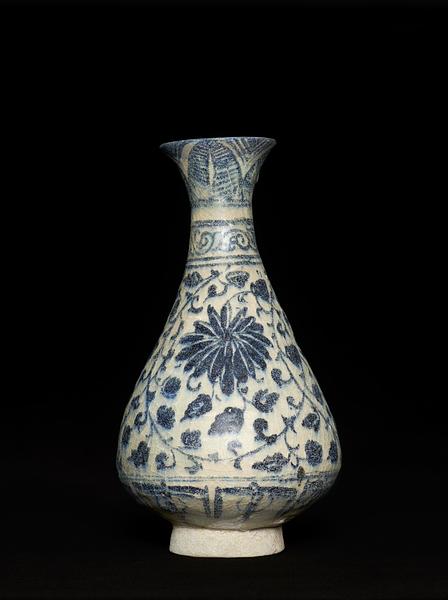Fritware bottle, painted in blue under a transparent glaze
Syria; beginning of 15th century
H: 28 cm
In around 1400, the blue and white pottery that was produced in the Middle East was almost completely under the influence of Chinese export porcelain with blue decoration. At times, the Syrian potters kept to a more Islamic ornamentation, but most often they transferred Chinese decoration to local forms. This pear-shaped bottle is quite an unusual example of Syrians not only copying a Chinese vine with a chrysanthemum, but also directly adopting a Chinese form.
Bottles of this
yuhuchun type are found on Timurid miniatures from the 15th century, but it was probably the coveted Chinese originals that were depicted.
Lent to the exhibition Mamluks 1250-1517
Louvre, Paris, France April 30 – July 28, 2025
September 17, 2025 - January 25, 2026
Inv. no. 29/1988
Published in:
Kjeld von Folsach: Islamic art. The David Collection, Copenhagen 1990, cat.no. 143;
Syrie: mémoire et civilisation, Institut du monde arabe, Paris 1993, p. 456, cat.no. 352;
Kjeld von Folsach, Torben Lundbæk and Peder Mortensen (eds.): Sultan, Shah and Great Mughal: the history and culture of the Islamic world, The National Museum, Copenhagen 1996, cat.no. 297;
Kjeld von Folsach: Art from the World of Islam in The David Collection, Copenhagen 2001, cat.no. 205;
David Abulafia [et al.]: Mediterraneum. Splendour of the Medieval Mediterranean 13th-15th centuries, History Museum of Catalunya, Barcelona 2004, p. 332;
Sheila S. Blair and Jonathan M. Bloom (eds.): Cosmophilia. Islamic Art from the David Collection, Copenhagen, McMullen Museum of Art, Boston College, Boston 2006, cat.no. 89;
Kjeld von Folsach: Flora islamica: plantemotiver i islamisk kunst, Davids Samling, København 2013, cat.no. 17;
Yuka Kadoi: The Blue road: mastercrafts from Persia, Liang Yi Museum, Hong Kong [2018], cat.no. C18, p. 74;
Linda Komaroff (red.): Dining with the Sultan: the fine art of feasting, Los Angeles County Museum of Art, Los Angeles 2023, cat.no. 14, p. 150;
Carine Juvin (ed.): Mamlouks: 1250-1517, Musée du Louvre, Paris 2025, p. 181, fig. 133 and p. 344, cat.no. 133;
